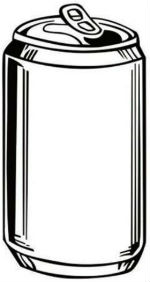Let us start with the question,
“Why is the bottom of a can a circle?”
Consider a circle, a square and an equilateral triangle
of the same circumference (perimeter), say 4π.
A circle has the largest area compared with that of other shapes. Here, we can infer that a can has the largest volume when it is a cylinder with a circle-shaped base for a fixed height. In other words, more contents can be held in a cylinder.
 | ||
Say a company wants to put X-amount of a drink in each package and we can change the height of the container this time. We find that a cylinder with the base of a circle has the smallest surface area given the same circumference of the base. Usually, the cost of producing packaging for a drink is about three times greater than to cost of the contents. Less material used in the packaging means bigger profits for the company.
Now, is a cylinder the most practical and economical shape for a can? If we consider a sphere, it can hold a large volume of content compared with a cylinder. However, it becomes much harder to store products when the container is sphere shaped because it will not stay in one place. So most economical - no, most practical - yes.
Last, but not least, “Why is a can’s bottom arch-shaped?” This is especially important for fizzy drinks. Here we introduce some chemical theory. It is arch-shaped so that an explosion of carbon dioxide due to gas expansion when the temperature rises can be prevented. Many people are unwilling to buy milk packages that are bulging. Even if the contents remain fresh, maintaining the shape of the container will increase the salability of product.
Last, but not least, “Why is a can’s bottom arch-shaped?” This is especially important for fizzy drinks. Here we introduce some chemical theory. It is arch-shaped so that an explosion of carbon dioxide due to gas expansion when the temperature rises can be prevented. Many people are unwilling to buy milk packages that are bulging. Even if the contents remain fresh, maintaining the shape of the container will increase the salability of product.
Bae Mi Seon
rrkseekdls@korea.ac.kr

